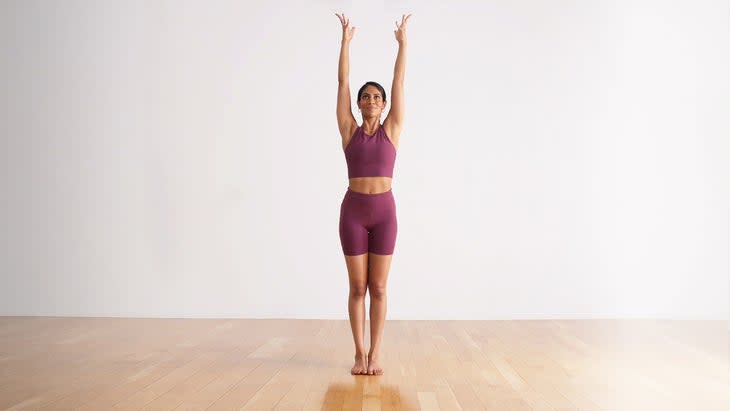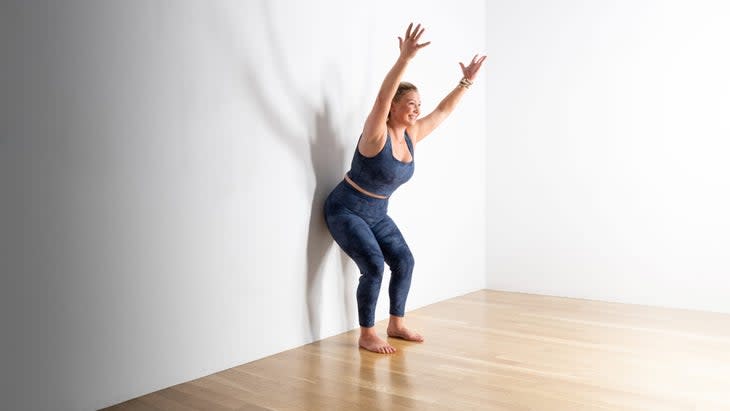10 Easy Yoga Poses to Practice When You Just Don’t Feel Like Doing Yoga
- Oops!Something went wrong.Please try again later.
This article originally appeared on Yoga Journal
There are some days when you just can't seem to make it to your mat. You wake up too late. Your schedule is too full. That class you were definitely going to take gets preempted by some other pressing obligation.
But sometimes it's not your busy schedule that gets in the way of your practice. There are days when you simply don't feel like practicing. You hit snooze again, or watch another episode of that Netflix series, or linger over a meal with your favorite people.
If you're a committed yoga practitioner, missing your practice can make you feel out of sorts or even like a fraud. But there is a way to honor your practice and your need to take it easy. You might call it minimalist yoga.
What's in your way?
I once heard Judith Hanson Lasater say that if you stand up straight then bend over and reach for your toes, you've done Tadasana and Uttanasana--and that counts as having practiced yoga that day. It was a great reminder that a minimalist approach to yoga is still yoga.
If minimizing your practice makes you feel lazy, well, let go of that myth. Psychologists say that the idea of laziness is a product of a culture that overvalues work and undervalues rest. Feeling “lazy” may mean that you actually need to rest or otherwise take care of yourself. You may need to spend some time on inward reflection to determine why you don't feel as motivated to practice. Shifting expectations and letting go of attachments is a yoga practice in itself.
Criteria for “lazy yoga”
If you're avoiding your mat because you feel sluggish, burned out, or tired, a short practice can lift your energy. Here are some poses to do when you don't really feel like doing yoga. It looks like lazy yoga. But, trust me, it's perfectly good yoga. Really, it is.
These are poses you can get into and out of easily. Don't worry about wrapping your foot behind your head or winding yourself into Astavakrasana (Eight-Angle Pose). But if you do every pose in this sequence--and there's no obligation to--you will have moved your spine in all directions and given yourself a full-body stretch. And each posture can be modified to suit your mood or your needs. (For example, they can all be done in a chair or even in bed.)
You can find detailed cues for each of these poses in the Yoga Journal Pose Library.

Urvha Hastasana (Upward Salute)
Whether you're just getting up in the morning or have been sitting all day, this pose-which some teachers call Tall Mountain-is intuitive. Your body wants to stretch. From Tadasana, reach both arms up and allow your torso to rise as well while you keep your shoulders away from your ears. Adjust your arm and hand position to suit what your shoulders need. You can practice with your hands apart in a v-shape, shoulder-distance apart, or palms pressing together overhead.
From Upward Salute, you can take a gentle side bend. Press your hips to the right as you curve your torso and reach your arms to the left. Your hands can be clasped or parallel, palms facing one another. Recenter and then curve to the other side.

Uttanasana (Standing Forward Bend)
From standing, fold forward into Uttanasana and let your arms hang loose, ragdoll style. As you allow the full weight of your head and torso to release toward the floor, you'll feel the stretch along the backs of your legs and torso. Unless you feel dizzy, you can hang here as long as you like and enjoy the sensation of your back releasing.

Utkatasana (Chair Pose)
Stand in Urdhva Hastasana or in Tadasana with your hands on your hips. Then bend your knees. That's it: Chair Pose. There are nuances to the posture-lean forward slightly, keep your back long, and allow your tailbone to tilt forward slightly as you zip your abs up. You can keep your hands on your hips, reach them straight in front of you at shoulder height, or take them in the traditional shape toward the ceiling. The pose is just as effective when you use the wall for support.

Dandasana (Staff Pose)
Sit on the floor with your legs extended straight in front of you. Lift your head toward the ceiling and extend your spine. Don't be fooled by Staff Pose: Holding yourself upright--belly and quads engaged--takes some effort from your muscles. When you're engaging your core, don't forget to breathe.

Paschimottanasana (Seated Forward Bend)
From seated, inhale and let your back be long. On an exhale, fold forward on an exhale, hinging at your hips and bringing your torso toward your thighs. Stretch forward as much as feels comfortable for you, bending your knees of your hamstrings feel tight. You can reach toward your shins or toes or keep your hands on your hips.

Baddha Konasana (Bound Angle Pose)
From seated, bend your knees and bring the soles of your feet together, opening your knees out to the side for Bound Angle. If your hips are tight, tuck blocks, blankets, towels, or a small bolster under your knees for support. (Bonus: You can do this pose reclined on your back or leaning back on bolsters or pillows.)

Salambasana (Locust Pose)
Lie face-down with your chin slightly tucked so your forehead rests on the floor. Extend your arms alongside your body. On an inhalation, arch your back and lift your head, shoulders, and chest off the floor for Locust Pose. With your palms facing your body or the floor, reach your hands toward your heels. Stay here for a breath or two, then lower down. If you like, practice the pose again, this time lifting your legs as well as your upper body.

Viparita Karani (Legs Up the Wall)
Sit with one hip snuggled against a wall. Then, in one smooth movement, lean away from the wall, bring your back to the floor, and bring your legs up the wall. Extend your arms by your sides, palms facing up, and lie in this pose, breathing steadily, until you are ready to release the pose. Then bend your knees and bring them into your chest. Pause before rolling over to one side.

Savasana (Corpse Pose)
Savasana looks like the easiest thing in the world. In fact, it can be a challenge-especially when you're agitated or worried. But allow yourself to just lie there. Take the opportunity to get comfortable lying on your back, arms and legs extended, and focusing on the sensation of the breath. This, too, is yoga.
For exclusive access to all of our fitness, gear, adventure, and travel stories, plus discounts on trips, events, and gear, sign up for Outside+ today.

